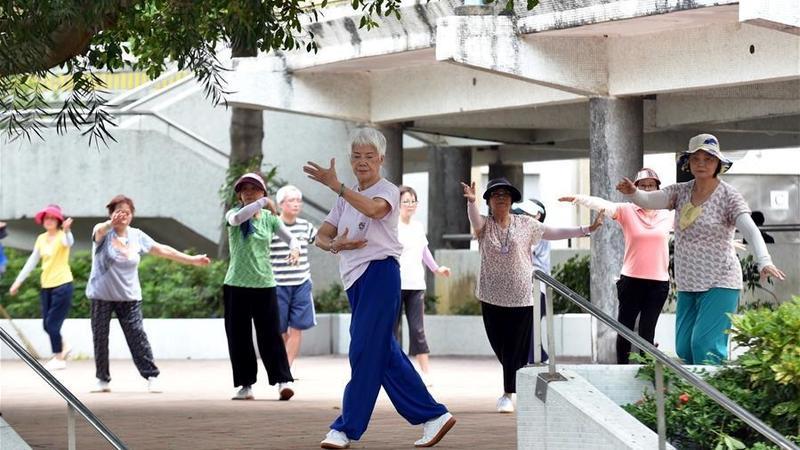Senior residents’ needs and hopes for a more comfortable life have become more distinct as Hong Kong tops the world with the longest average life expectancies for men and women. Experts see the silver economy as enormous, aided by the rapid advance of technology. Li Xiaoyun reports from Hong Kong.

The economic power of senior residents is growing by the day with higher life expectancies worldwide and the Hong Kong Special Administrative Region leads the pack.
And technology is fueling the growth of the silver economy.
At the recent Hong Kong Electronics Fair (Spring Edition), which ended on April 16, a Shenzhen-based technology firm showed off an upgraded version of one of its products — a more affordable, lightweight and wearable device that helps the elderly to walk. Yu Yunbo, chief executive officer of Kenqing Technology, says the company, which specializes in the research and development of exoskeleton robots, is betting big on the business opportunities created by a fast aging population, with huge potential in the Hong Kong market.
“We’ll definitely step up investing in the research and development of technology products and solutions tailored for the elderly,” he says.
READ MORE: Hong Kong govt sets up panel on developing 'silver economy'
Yu isn’t alone in recognizing the potential of the elderly-friendly market. At the Gerontech and Innovation Expo cum Summit held in Hong Kong in November last year, more than 200 global exhibitors displayed nearly 800 technology products geared to meeting the needs of senior residents.
As more businesses recognize the growing demand from aging consumers, experts and industry insiders are convinced there’s a lack of products and services tailored for the elderly in Hong Kong. To bridge the supply gap, they point to the importance of technology, saying the SAR government should play a bigger role in this respect.
Hong Kong, like many other developed regions and economies, is seeing a demographic shift characterized by an aging population. The Census and Statistics Department revealed in February 2022 that the proportion of local residents aged 65 and above had risen from 13 percent in 2011 to 20 percent in 2021, and it is expected to reach 36 percent by 2046. The demographic trend presents both challenges and opportunities for the local economy.
Based on the latest United Nations population estimates released last year, the HKSAR topped the world with an average life expectancy of 85.83 years for both sexes, 88.66 years for females and 83 years for males. The Macao SAR was second with 85.51 years for both sexes, 88.11 years for females and 82.88 years for males. Japan and Switzerland came in third and fourth with an average life expectancy of 84.95 years and 84.38 years for both sexes, respectively.
An aging population and its mounting strain on public finances is a pressing global issue, not just for Hong Kong. The city’s healthcare expenditure is projected to outpace the growth rate of its gross domestic product at least for the next four years, with aging as the primary cause, according to an economic policy report by the University of Hong Kong in January.
But a growing elderly population also brings economic benefits. The World Health Organization estimates that the global market of the silver economy — an economic model aimed at unleashing the consumption potential of the elderly — will reach $38 trillion next year. On the Chinese mainland, the consumer market for the elderly is also accelerating, with an average annual growth rate of 15.2 percent.
Hong Kong, as one of the world’s wealthiest regions, is set to reap these business opportunities. According to the Ageing Asia Silvery Economy Index, the city ranks fourth globally and second in the Asia-Pacific region in terms of the consumer capacity of the elderly and their children.
“Developing Hong Kong’s silver economy may help alleviate the public finances burden caused by an aging population by introducing the strength of the private sector,” says Ma Kai-yum, executive vice-president of the Chinese Manufacturers’ Association of Hong Kong. Moreover, it’ll provide an opportunity to nurture and strengthen related industries, contributing to the diversified growth of the local economy.

Gerontech’s acceptance
Taking a leaf out of the book of developed economies like Japan and the European Union, which have made early strides in building up the silver economy, Ma says technology should play a pivotal role. Industries usually refer to such technology as gerontechnology, representing an interdisciplinary field that leverages existing and emerging technologies to meet the specific needs and aspirations of aged and aging adults.
Currently, the use of many gerontechnology products is limited to home care or community care, such as fall detection devices and toilet aids, says Stuart Gietel-Basten, professor of social science and public policy at the Hong Kong University of Science and Technology, adding that these products are more about design, but not technology. “The primary function of gerontechnology goes beyond enabling the elderly to live independently. It also aims to ensure their well-being.”
For instance, senior residents with swallowing difficulties, medically referred to as dysphagia, are unable to consume regular solid meals due to the risk of aspiration pneumonia and other severe complications. Their meals often consist of soft, pureed foods, like “baby food”, says Gietel-Basten, and this may affect their appetite and dignity.
Lately, specialized food, with a soft texture but retaining the appearance and taste of regular food, has been developed for the elderly with dysphagia. Gietel-Basten considers this as a small, yet typical example of gerontechnology. It not only ensures the safety of seniors, but also provides a pleasurable dining experience while preserving their quality of life.
To realize the benefits of gerontechnology, experts have identified two challenges that need to be addressed — the elderly have a lower level of literacy and acceptance of technology products compared to the younger generation, and the SAR government should take further measures to develop gerontechnology.
Although the newer generation of seniors has seen an increase in educational attainment and corresponding acceptance of technology and digital products, experts and industry insiders note that the elderly still maintain a cautious and conservative attitude toward technology.
Yu argues that although the elderly do use gerontechnology, the consumption trend lies largely with young people. Based on his observations, Kenqing Technology’s products are designed for users of all age groups, as older people’s acceptance of gerontechnology often begins when they see positive feedback from younger users, he says.
Gietel-Basten points out that a possible reason for the relatively low acceptance of gerontechnology among the elderly is that the existing products fail to meet their genuine needs. As an educator with close ties to younger generations, he says the development of gerontechnology may not be viewed as “sexy” by young people. For example, engineering or computer science graduates may find the creation of a trendy mobile app more “attractive” than developing home care systems for the elderly. This isn’t just a challenge for Hong Kong but for the world.
Designing and creating gerontechnology products and solutions is still largely done by the younger generation, without direct involvement of users or seniors, and this could lead to a mismatch between the ideas of young developers and the actual needs of the elderly population, says Gietel-Basten. He suggests that universities and research institutions conduct systematic and scientific studies to gain a more comprehensive and detailed understanding of consumption preferences and the behavior of the elderly, and the government could fund such efforts.

Leading the charge
From a macro policy perspective, Ma would like to see the SAR government play a leading role in developing gerontechnology by making it a key area of the innovation and technology sector, and increasing funding for it.
While Hong Kong’s Innovation and Technology Fund, as well as Social Innovation and Entrepreneurship Development Fund, do not have dedicated streams for gerontechnology, they’ve supported projects that leverage technology to improve the lives of seniors. Ma says the government can consider expanding the scope of these funds, or establishing a new funding program specifically for senior-friendly tech initiatives.
In addition, as the formulation of industry standards for gerontechnology products and services in Hong Kong is still in its infancy, Ma wants the government to take the lead in setting industry guidelines and encouraging industry players to participate in the process.
Sun Jie — a member of the Chinese People’s Political Consultative Conference National Committee and deputy dean of the School of Insurance and Economics at the University of International Business and Economics — suggests that enterprises play an active role in setting industry guidelines for gerontechnology, and that their participation would strengthen market norms and help create unified standards in elderly-oriented transformation.
To bolster homegrown brands, Ma hopes the government will prioritize the use of locally developed gerontechnology products in its own departments and public institutions in providing services for the elderly.
The SAR government has taken note of the silver economy’s potential, as well as its responsibilities in this regard. In his second Policy Address in October last year, Chief Executive John Lee Ka-chiu stressed the importance of developing the silver economy. “The growing elderly population is emerging as a main consumer group, creating considerable demand for such products and services as medical and healthcare, leisure and recreation, and home and personal care catered for the elderly,” he said.
In alignment with this proposal, the Advisory Panel on Silver Economy was set up on Feb 20 and held its first meeting to conduct research on market demand and the silver economy’s development. The panel consists of 15 members of government departments, statutory bodies, and the business and social welfare sectors, with Algernon Yau Ying-wah, secretary for commerce and economic development, as chairman.
“I’m glad to see the panel is led by the bureau responsible for industrial development,” says Ma. “I hope it’ll take a market-oriented approach in charting the course for developing Hong Kong’s silver economy.”
ALSO READ: More GBA hospitals to accept HK elderly healthcare vouchers
Although the number of senior residents in Hong Kong is growing, the city’s seven-million-plus population is relatively small compared with that of the entire Guangdong-Hong Kong-Macao Greater Bay Area, which has more than 86 million people. Kenny Shui, vice-president of think tank, Our Hong Kong Foundation, says if Hong Kong can collaborate with mainland cities in the Greater Bay Area on gerontechnology, a “win-win” outcome could be achieved.
According to UN standards, Hong Kong is considered a “moderately aged society” and the Chinese mainland is projected to reach that threshold by 2025. Against this backdrop, the State Council discussed the formulation of policies to develop the silver economy and enhance the well-being of the elderly at its first executive meeting of this year.
Hong Kong’s deep-rooted international connections allow the city to introduce advanced global practices and products to the mainland, while Guangdong province, as a manufacturing powerhouse, can leverage its robust industrial base and applied research capabilities to support the SAR’s silver economy.
Zhou Mo contributed to this story.
Contact the writer at irisli@chinadailyhk.com


